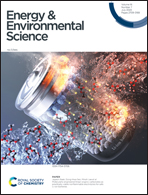Dimethyl ether/CO2 – a hitherto underestimated H2 storage cycle†
Abstract
Large amounts of renewable energy will have to be stored and transported in the future. For this task, chemical hydrogen storage technologies are particularly suitable. In this paper, we show that the DME/CO2 storage cycle is especially promising for point-to-point transport of renewable hydrogen over long distances. Surprisingly, this technology has been neglected so far, as DME has been mostly discussed as a fuel substitute for internal combustion engines while the back transport of CO2 has not been considered in this context. Our study reveals that the similarity of the physico-chemical properties of DME and CO2 enables back-shipping of CO2 after hydrogen release in the same vessel that is used to transport DME. This leads to an overall technology that shows in our analysis considerable potential to outperform ammonia or methanol, which are intensively discussed as hydrogen vectors today. The proposed cycle is characterised in particular by comparatively high energy efficiency, reduced mass flows per ton of delivered hydrogen, lower water consumption at the hydrogen production site and lower toxicological risks.

- This article is part of the themed collection: Recent Open Access Articles


 Please wait while we load your content...
Please wait while we load your content...